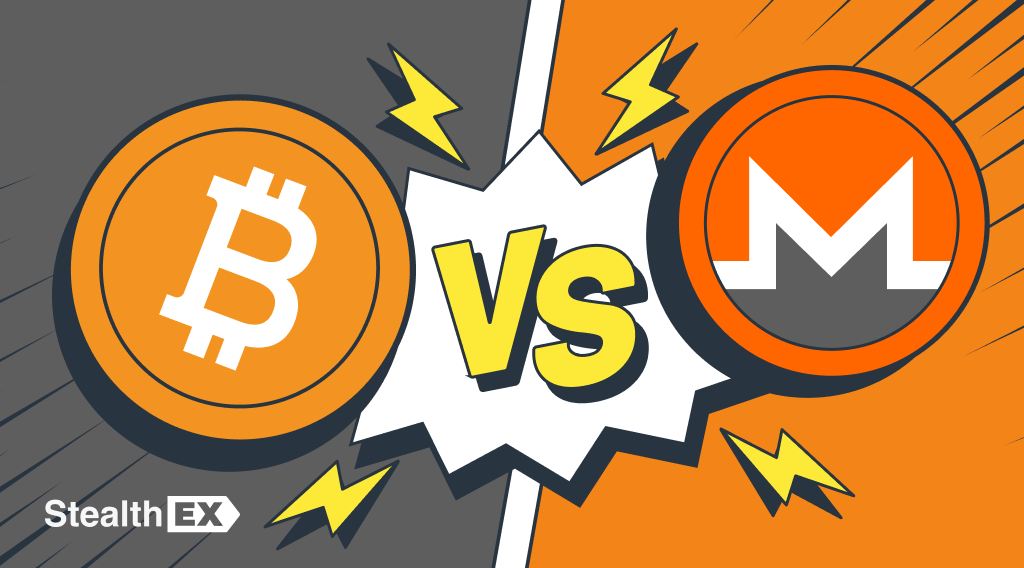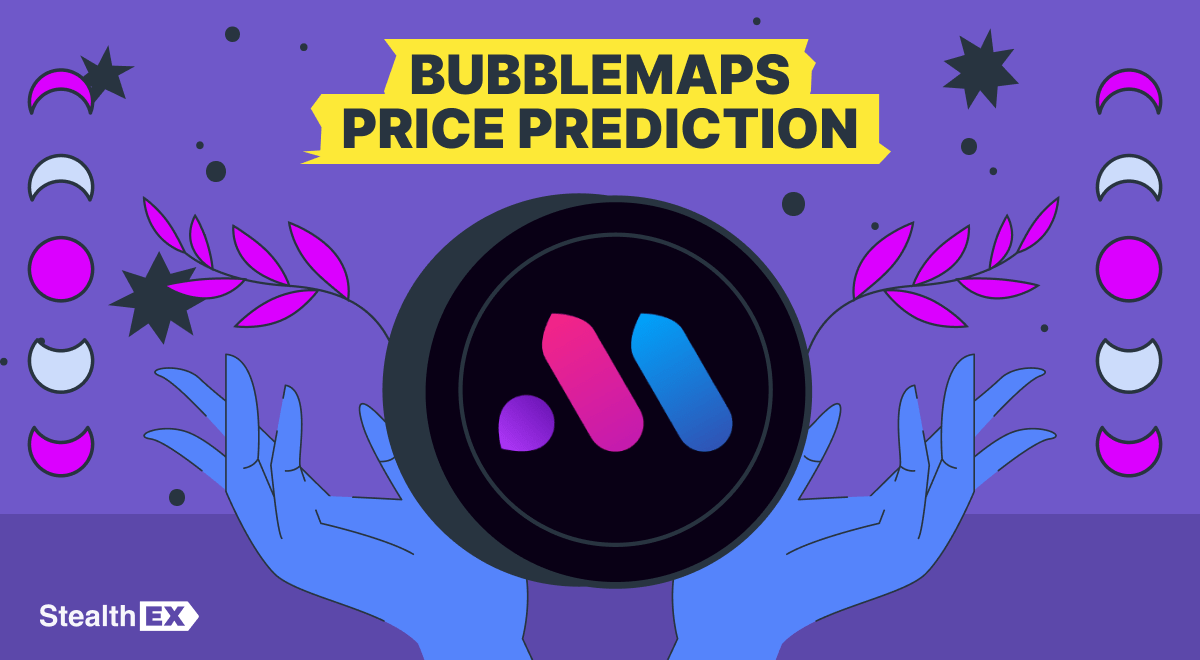Monero vs Bitcoin: What Are the Main Differences? The Ultimate Comparison

When it comes to crypto investments, many investors wonder if swapping Bitcoin for Monero as the main digital asset in their portfolio would be more profitable and even safer. This article compares Monero (XMR) and Bitcoin (BTC), focusing on their technology, characteristics, privacy, and investment potential. Get a general understanding of these two cryptocurrencies as we explore their similarities and differences in our concise yet thorough Monero vs Bitcoin analysis.

Article contents
What Is Monero?
Monero (XMR) is one of the very popular, so-called ‘private’ cryptocurrencies. It is a privacy-oriented and open-source cryptocurrency. It is recognized for its non-transparent structure, fungibility, and accessibility. Monero’s decentralized blockchain has been designed to be private. As a result, it permits obscuring important transaction information including the sender and recipient’s identities as well as the transaction’s total value. In the end, transactions’ anonymity increases blockchain’s security.
In addition to this, Monero is one of the best options when it comes to safety. It leverages the opaque blockchain and makes all the transactions untraceable and anonymous. Monero employs advanced cryptographic techniques to obfuscate transaction details, making it much more difficult to trace transactions and associate them with specific individuals.
Moreover, Monero is fungible, i.e. easily replaceable by an identical item or mutually interchangeable. Therefore, you can easily exchange as well as transact Monero without any problems. The majority of cryptocurrencies are partially fungible. However, the good news is that Monero is completely fungible.
In conclusion, one of the most interesting features of Monero is that it is less volatile than other crypto assets; some even refer to it as being the ‘stable cryptocurrency.’
What Is Bitcoin?
Bitcoin (BTC) is the first and most well-known cryptocurrency, created in 2009 by an anonymous person or group using the pseudonym Satoshi Nakamoto. It operates on a decentralized peer-to-peer network without the need for intermediaries like banks. Bitcoin transactions are recorded on a public ledger called the blockchain, secured through cryptographic techniques. Bitcoin combines its network, cryptocurrency, and blockchain to record transactions transparently, prevent double spending, and ensure consensus via a process called ‘Proof-of-Work.’
Bitcoin has a limited supply of 21 million coins, making it deflationary in nature. Bitcoin’s value is determined by market demand and is known for its price volatility.
Bitcoin is not completely anonymous, it’s pseudonymous. Thus, while Bitcoin transactions are not directly linked to individuals’ identities, the transaction history is stored on a public ledger called the blockchain. This ledger is transparent and can be accessed by anyone. It means that if someone can associate a Bitcoin address with a specific person, they can potentially trace their transaction history.
Monero vs Bitcoin: An Overview
Privacy Features
When it comes to privacy, it is primarily about stealth addresses. These are disorganized, one-time addresses that have nothing to do with any shared or previously put regular addresses. Put simply, on the public ledger, a few transactions sent to the same standard Monero address will appear to have been sent to completely different addresses. The thing is that although you can withdraw the coins that have been deposited to this kind of address, the money is not connected to you in any way. Senders and recipients are the only ones who know the location of XMR transfers. Some crypto platforms, for instance, Houdini Swap, use Monero as a way to make transactions private.
Ring transactions are an additional fantastic privacy feature. It is an amalgam of two excellent privacy technologies: private transactions and ring signatures. The Bitcoin project is underpinned by regular cryptographic signatures, and users validate transactions using their private key, which verifies ownership of the coin that will be spent in a transaction. Ring signatures attest to possession as well, but they also imply an additional degree of uncertainty.
The digital assets used as ‘decoys’ in the same transaction may contain extremely dangerous ones, and it’s unclear which of them were verified. This complicates the process of determining which money was authorized and disbursed. Decoys are blended ten to a set for each transaction. Because of this, Monero is quite challenging to follow.
However, Bitcoin has also made steps towards privacy. For example, certain wallets based on Bitcoin, such as Samourai Wallet, recommend optional stealth addresses. Another feature that mixes coins is called ZeroLink. This makes it difficult to determine who is the true owner of the coins and where they came from.
Mining Features
The ‘Proof-of-Work mining’ theory underpins the operation of both tokens. What is entered into a ledger is approved by the participants or miners. These men use their hardware in a rush to solve mathematical equations. If someone had been ahead, they would have been rewarded with fresh Bitcoin or XMR and their unique block would have been added to the network.
Different mining protocols are used by Bitcoin and Monero projects. The SHA-256 algorithm used by Bitcoin runs on hardware known as application-specific integrated circuits (ASICs). They are made especially for mining Bitcoin and are highly expensive. These days, mining on a PC is pointless because ASIC users offer fierce competition.
Success is clearly on the side of those who own ASICS. However, they use a lot of energy and are not very cheap. Because of this, mining Bitcoins in places with cheap electricity is now a decentralized operation. This method of obtaining Bitcoin appears hard to the average person.
Scalability
The project’s scalability is determined by how many transactions it can process in a second. This is also a crucial component for success in the field. Another aspect that we may evaluate between XMR and BTC is scalability, or the capacity to manage large volumes of transactions. Unfortunately, both businesses struggled to meet the high demand during the crypto boom in 2017.
Both saw a sharp increase in the average transaction commission, indicating that they were not prepared for regular use. Transaction commissions were significantly greater than those of low-commission payment methods (such as credit cards, PayPal, Venmo, and Venmo), even if they might have been more or less equal to bank transfer commissions.
But in this case, Bitcoin wins since Monero lacks the necessary expertise to handle thousands of transactions every day. Bitcoin is currently processing hundreds of thousands of transactions every day. As of right now, Monero is unable to compete with large payment networks because its small transaction volume has already caused scalability concerns.
Regulatory Issues
While Bitcoin has been accepted by many governments and countries all around the world, Monero is struggling under legal pressure. The potential of privacy coins for illicit operations, like money laundering and tax evasion, has alarmed governments and financial regulators around the world.
These concerns have led to increased regulatory scrutiny and in some cases, forced cryptocurrency exchanges to delist Monero and other privacy coins. Delisting might reduce Monero’s liquidity and accessibility, making it more difficult for consumers to purchase, exchange, and use the cryptocurrency. This hinders uptake and lessens Monero’s prospects of success in the already fiercely competitive cryptocurrency space.
Meanwhile, Bitcoin has even made it to become a legal tender: El Salvador became the first country to make bitcoin legal tender; not only must Bitcoin be accepted as a means of payment for taxes and debts, but also businesses are required to accept BTC as a medium of exchange.
Monero vs Bitcoin – Key Differences Between XMR and BTC
Monero (XMR) and Bitcoin (BTC) are both very popular assets within the crypto industry, but they have distinct features and capabilities. Here’s a breakdown of the key differences between these two projects:
- Transaction speed – Monero’s shorter block times result in faster transactions compared to Bitcoin’s longer confirmation times.
- Fees – Monero generally provides lower and more predictable fees due to dynamic block size adjustments, whereas Bitcoin fees can vary widely.
- Scalability – Monero has more promising scalability prospects, with dynamic block size and ongoing efforts to enhance scalability, while Bitcoin constantly battles with scalability issues.
- Mining – Monero employs an ASIC-resistant RandomX algorithm for CPU/GPU mining, fostering decentralization, whereas Bitcoin’s SHA-256 algorithm is dominated by ASICs.
- Privacy – Monero gives its users the ultimate privacy features by making transactions challenging to trace, while Bitcoin’s transactions are pseudonymous, with a number of privacy BTCutions.
- Development – Monero boasts an active development community with a focus on privacy and security improvements, while Bitcoin primarily serves as a digital store of value.
- Different goals – Bitcoin focuses on providing a decentralized, transparent, and secure means of transferring and storing value, and Monero prioritizes privacy and fungibility, aiming to make transactions as anonymous and indistinguishable as possible.
Choose StealthEX for Exchange and Buy Crypto
- User-Friendly — Simple and minimalistic interface for everyone.
- Fast and Private — Instant non-custodial cryptocurrency exchanges.
- Buy crypto with Credit Card.
- 1500+ coins and tokens are available for limitless, quick and easy exchanges.
- NO-KYC crypto exchanges — Buy cryptocurrency up to $700 without KYC!
- StealthEX crypto exchange app — Process crypto swaps at the best rates wherever you are.
- 24/7 Customer Support.
Earn from Each Exchange by Joining StealthEX Affiliate Program.
Become a partner right now and use affiliate tools:
- Public API — Earn from your wallet, aggregator, or exchange terminal.
- Referral Links — Recommend StealthEX to your audience.
- Exchange Widget — Built crypto exchange widget on any page of your website.
- Button — A perfect choice for traffic monetization.
- Banner — Track conversion and stats right in the personal cabinet.
Monero vs Bitcoin – Key Similarities Between XMR and BTC
While Monero (XMR) and Bitcoin (BTC) have their unique features, they also share several key similarities. Let’s take a look at what brings these two major players in the industry closer:
- Consensus Mechanism – Both platforms use the PoW (Proof-of-Work) consensus mechanism.
- Cryptocurrency Tokens – XMR and BTC are the native cryptocurrencies of Monero and Bitcoin, respectively. These tokens are used for transactions, network fees, and participating in governance.
- Blockchain technology – Both Monero and Bitcoin are built on blockchain technology. They offer decentralized BTCutions, moving away from traditional centralized systems.
- Global Reach – Monero and Bitcoin have a global user base. They aim to provide blockchain solutions across various industries worldwide.
In essence, Monero and Bitcoin, despite their differences, are important bricks in today’s crypto industry’s foundation, serving as means of storing value and transferring payments.
Monero vs Bitcoin – Comparison Table
| Feature | Monero (XMR) | Bitcoin (BTC) |
| Year of Creation | 2014 | 2009 |
| Purpose | Digital currency and store of value | Conducting censorship-resistant transactions |
| Consensus Mechanism | Proof-of-Work | Proof-of-Work |
| Transaction Speed | ~6 transactions per second | ~7 transactions per second |
| Supply Limit | Capped at 18.4 million XMR | Capped at 21 million BTC |
| Block Time | ~2 minutes per block | ~10 minutes per block |
| Development Approach | Maintains egalitarian mining, so that everyone can have the possibility to mine | Allows for neutrality towards developers, users, and miners |
| Technology Base | Blockchain | Blockchain |
| Native Cryptocurrency | XMR | BTC |
| Governance | Sovereign-grade censorship-resistance | On-chain governance |
| Popularity | The most private coin on the market | The first and most well-known cryptocurrency |
| Global Reach | Worldwide user base, diverse applications | Worldwide user base, diverse applications |
Future Outlook on XMR and BTC
Because of its many wallet alternatives, accessibility throughout the world, and increasing institutional interest, Bitcoin has become more widely accepted and is currently accepted as payment by a number of well-known companies. The Lightning Network also enhances its utility for everyday transactions.
However, Monero’s main advantage is its strong privacy features, which guarantee both transaction anonymity and user security. But these very characteristics also add to its regulatory issues because of worries about compliance and anonymity, as well as its public perception issue because it is frequently linked to illegal activity.
While both cryptocurrencies have a huge potential, the crypto landscape is always subject to change, so the pendulum can swing, making one of these assets more sought-after. Moreover, crypto volatility can shrink any potential investments in both XMR and BTC, making this a risky option for traditional investors. As with any investment, it’s best to do your own research and stay updated about regulatory changes in the crypto environment.
Summary
Both Bitcoin and Monero are different cryptocurrency strategies, each with its own special characteristics and advantages. Being the first cryptocurrency, Bitcoin provides visibility, liquidity, and a value store comparable to digital gold. Because of its transparency, auditability and regulatory compliance are made possible in addition to financial traceability.
However, Monero puts privacy first, offering users the highest level of transaction confidentiality and anonymity. Because all currencies are equal thanks to their fungibility, there is less reason to worry about tainted cash. The goal of financial security and anonymity is something that Monero’s community actively supports.
In the end, it’s up to you to decide how XMR or BTC aligns with your personal investment goals. However, should you wish to buy either of these popular cryptocurrencies, check out StealthEX, your ultimate instant exchange where you will be able to buy not only Monero and Bitcoin, but also a variety of other cryptocurrencies – safely, quickly, and easily.
Follow us on Medium, Twitter, Telegram, YouTube, and Publish0x to stay updated about the latest news on StealthEX.io and the rest of the crypto world.
This article is not supposed to provide financial advice. Digital assets are risky. Be sure to do your own research and consult your financial advisor before investing.
Bitcoin BTC to XMR cryptocurrency Monero privacy coinsRecent Articles on Cryptocurrency
 PEPE Coin Price Prediction: When Will PEPE Reach $1?
PEPE Coin Price Prediction: When Will PEPE Reach $1?  Bubblemaps Price Prediction: Is BMT Coin a Good Investment?
Bubblemaps Price Prediction: Is BMT Coin a Good Investment? 